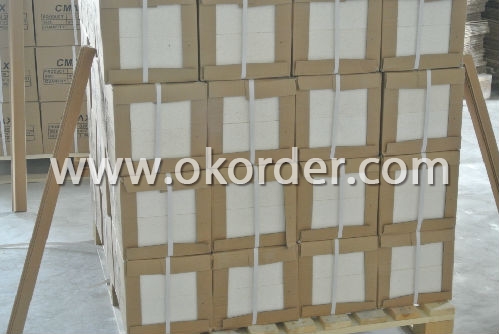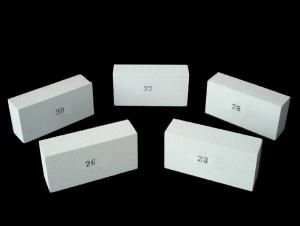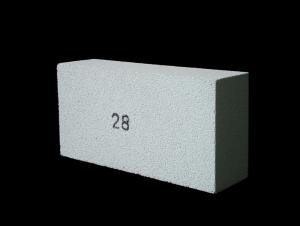Insulating Fire Brick-GJM28
- Loading Port:
- China Main Port
- Payment Terms:
- TT or L/C
- Min Order Qty:
- 1000 pcs pc
- Supply Capability:
- 1000 Tons Per Month pc/month
OKorder Service Pledge
OKorder Financial Service
You Might Also Like
General Information of Insulating Fire Brick GJM28
Insulating fire brick GJM28 are produced by high purity alumina and low iron raw materials. A viariety of shapes are available.
To make our firebricks more energy and cost effective, we have different manufacturing methods for our insulating fire bricks casting and extruding method.
For insulating fire bricks GJM28,we choose the extruding method. Extruding insulating fire bricks have better strength and offering great performance in load bearing applications and in conditions where abrasion from mechanical abuse or flow of hot gases.
Characteristics of Insulating Fire Brick GJM28
The organic fillers, which are mixed in the materials and then burned out during sintering, give our insulating fire bricks a uniform controllable pore structure. The insulating fire bricks exhibit the following characteristics:
Light weight and low thermal conductivity allows thinner furnace walls
Maintain stable structural strength throughout ambient to maximum service termperature
Low heat storage results in rapid cooling and heating operation
Low iron and impurities to enhance reducing atmosphere
High thermal shock resistance in preventing spalling
Typical Application of Insulating Fire Brick GJM28
Ceramic shuttle kilns
Metal heat treatment furnaces
Steel billet reheating furnaces
Oil refrinery heaters
Laboratory furnaces
Backup insulation for all furnaces
Technical Data of Insulating Fire Brick GJM28
|
| GJM28 |
Physical Properties: |
|
|
Classifiction Temperature | ℃ | 1500.0 |
Density | Kg/m3 | 900.0 |
Cold Crushing Strength | Mpa | 2.5 |
Reheating Linear Change(24hrs) |
|
|
1510℃ | % | 0.6 |
Hot Load Strength Deform(90 minutes) |
|
|
1320℃ at 0.069 Mpa(10psi) | % | 0.3 |
Thermal Conductivity |
|
|
400℃ | W/m.k | 0.3 |
600℃ | W/m.k | 0.3 |
800℃ | W/m.k | 0.4 |
1000℃ | W/m.k | 0.4 |
1200℃ | W/m.k | 0.4 |
Specific Heat | KJ/Kg.K | 1.1 |
Chemical Analysis: |
|
|
Al2O3 | % | 60.0 |
SiO2 | % | 38.2 |
Fe2O3 | % | 0.6 |
TiO2 | % | 0.1 |
CaO | % | 0.1 |
MgO | % | 0.1 |
Na2O+K2O | % | 0.8 |
We has success in insulating fire bricks due to their cost-effectiveness, excellent insulation properties. CNBM also has experience in insulating fire bricks application and would like to assist you in product selection, system design, and installation techniques.


- Q:Are insulating fire bricks suitable for use in cement plants?
- Insulating fire bricks are indeed suitable for utilization in cement plants. Crafted from lightweight refractory materials, these bricks are specifically designed to withstand high temperatures and thermal shock. Their low thermal conductivity allows for effective insulation against heat transfer. In cement plants, where the production process generates elevated temperatures, insulating fire bricks can be applied in various ways. For instance, they can be utilized to line the kiln, which subjects raw materials to extreme temperatures in order to produce cement clinker. By possessing insulating properties, these bricks aid in minimizing heat loss and enhancing energy efficiency within the kiln. Moreover, insulating fire bricks can be employed to line the preheater tower and other areas within the cement plant that experience high temperatures. In doing so, these bricks provide both insulation and protection against the intense heat, consequently prolonging the lifespan of the equipment and reducing maintenance costs. Furthermore, the lightweight nature of insulating fire bricks renders them easier to handle and install in comparison to traditional refractory bricks. Consequently, this can save time and labor during the construction or repair of cement plant equipment. On the whole, insulating fire bricks are a suitable option for utilization in cement plants due to their resistance to high temperatures, low thermal conductivity, and ease of installation. Their implementation can contribute to enhanced energy efficiency, equipment durability, and cost savings within cement plant operations.
- Q:Can insulating fire bricks be used for insulation in sewage treatment plants?
- Insulating fire bricks are capable of being utilized for insulation purposes in sewage treatment plants. Specifically designed to endure elevated temperatures and deliver exceptional insulation, these bricks prove to be suitable for deployment in environments characterized by heat and moisture, such as sewage treatment plants. With their low thermal conductivity, they aid in diminishing heat loss and enhancing energy efficiency throughout the treatment procedure. Furthermore, their resistance to chemicals and moisture renders them ideal for enduring the corrosive surroundings typically encountered in sewage treatment plants. Consequently, the usage of insulating fire bricks effectively ensures insulation in sewage treatment plants, thereby aiding in the preservation of optimal operating temperatures and the enhancement of overall efficiency.
- Q:Can insulating fire bricks be used in chimney construction?
- Yes, insulating fire bricks can be used in chimney construction. Insulating fire bricks are designed to have low thermal conductivity, which means they are effective in reducing heat transfer. This makes them suitable for chimney construction as they can help to keep the chimney walls cooler and prevent excessive heat from transferring to the surrounding structures. Additionally, insulating fire bricks are lightweight and have good insulation properties, making them easier to handle and install in chimney construction. However, it is important to note that insulating fire bricks should be used in conjunction with other fire-resistant materials in order to meet safety regulations and ensure proper chimney construction.
- Q:Are insulating fire bricks resistant to thermal bridging?
- Yes, insulating fire bricks are resistant to thermal bridging. Thermal bridging occurs when there is a direct path for heat to flow through a material, bypassing the insulation. Insulating fire bricks are designed to minimize this by having low thermal conductivity, which means they are not effective at conducting heat. This helps to maintain a consistent temperature on both sides of the brick, preventing thermal bridging and improving the overall insulation performance.
- Q:Can insulating fire bricks be used for insulation in boilers?
- Yes, insulating fire bricks can be used for insulation in boilers. Insulating fire bricks are specifically designed to withstand high temperatures and provide excellent thermal insulation. They have low thermal conductivity, meaning they can effectively reduce heat loss and improve the energy efficiency of boilers. Additionally, insulating fire bricks are lightweight and easy to install, making them a popular choice for insulation in boilers. They can help maintain high temperatures inside the boiler, allowing for efficient combustion and heat transfer, while also protecting the outer structure from excessive heat. Overall, insulating fire bricks are a reliable and effective choice for insulation in boilers.
- Q:Can insulating fire bricks be used as a lining for incinerators?
- Yes, insulating fire bricks can be used as a lining for incinerators. Insulating fire bricks have excellent thermal insulation properties, which help to reduce heat loss, increase energy efficiency, and maintain high temperatures within the incinerator. Additionally, they can withstand high temperatures and provide good resistance to thermal shock and chemical erosion, making them suitable for lining the walls, floors, and roofs of incinerator chambers.
- Q:Are insulating fire bricks resistant to ammonia gas?
- Insulating fire bricks, in general, lack resistance against ammonia gas. Although these bricks are engineered to endure elevated temperatures and offer thermal insulation, they are commonly constructed from lightweight refractory materials, like clay or silica, which are not particularly resilient to corrosive substances such as ammonia gas. Over time, ammonia gas can react with these materials and result in deterioration or harm to the bricks. Consequently, if you require fire bricks for an environment containing ammonia gas, it is advisable to opt for specially designed acid-resistant or chemical-resistant bricks that can endure the corrosive impact of ammonia gas.
- Q:How shall the sintered porous self insulation bricks be laid at the bottom of the beam?
- And the concrete beam should be broken brick masonry. Top packing.
- Q:Do insulating fire bricks have a high resistance to spalling?
- Insulating fire bricks possess a remarkable ability to resist spalling. Spalling occurs when the surface of a material breaks or flakes off, and fire bricks are particularly susceptible to this phenomenon due to exposure to intense heat and thermal shock. However, insulating fire bricks are specially engineered to endure these extreme temperatures and thermal cycling, resulting in a significant resistance to spalling. These bricks are crafted from top-notch refractory materials like alumina or silica, renowned for their exceptional thermal shock resistance. Furthermore, they are manufactured with low thermal conductivity, effectively reducing heat transfer and minimizing the chances of spalling. In summary, insulating fire bricks are the perfect choice for applications demanding high spalling resistance, such as furnaces, kilns, and other environments with elevated temperatures.
- Q:Can insulating fire bricks be used in refractory lining for steelmaking?
- Yes, insulating fire bricks can be used in refractory lining for steelmaking. They are effective in providing insulation and thermal stability, helping to maintain high temperatures and protect the surrounding structures. Additionally, insulating fire bricks have low thermal conductivity and are lightweight, making them suitable for steelmaking processes that require heat retention and energy efficiency.
1. Manufacturer Overview |
|
|---|---|
| Location | Jiangsu, China |
| Year Established | 2008 |
| Annual Output Value | Above US$ 35 Million |
| Main Markets | Germany; Italy; Turkey; France; England; Japan; Thailand; Vietnam; Idonesia; USA |
| Company Certifications | ISO 9001:2008 |
2. Manufacturer Certificates |
|
|---|---|
| a) Certification Name | |
| Range | |
| Reference | |
| Validity Period | |
3. Manufacturer Capability |
|
|---|---|
| a)Trade Capacity | |
| Nearest Port | Shanghai; Qingdao |
| Export Percentage | 10% |
| No.of Employees in Trade Department | 3 People |
| Language Spoken: | English; Chinese; |
| b)Factory Information | |
| Factory Size: | Twenty five thousand tons per year |
| No. of Production Lines | Above 5 |
| Contract Manufacturing | OEM Service Offered; Design Service Offered |
| Product Price Range | High; Average |
Send your message to us
Insulating Fire Brick-GJM28
- Loading Port:
- China Main Port
- Payment Terms:
- TT or L/C
- Min Order Qty:
- 1000 pcs pc
- Supply Capability:
- 1000 Tons Per Month pc/month
OKorder Service Pledge
OKorder Financial Service
Similar products
New products
Hot products
Related keywords


























